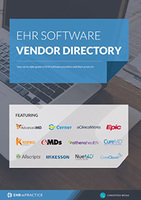EHR Interoperability and Meaningful Use: A match made in heaven
The Meaningful Use initiative was created to help providers gather, store and share electronic patient health information to achieve more streamlined and optimized patient care. One of the important components in achieving Meaningful Use is the sharing of this data with other healthcare providers as well as governmental agencies. In this way, governmental agencies can collect required data and use this data to improve best practices in public health management.
Data exchange isn’t enough
Most healthcare practices that have adopted EHR technology have done a good job of reaching Stage 1 and even Stage 2 of the governmental goals for achieving meaningful use (Stage 1: capture/share data, Stage 2: advanced care processes with decision support, Stage 3: improved outcomes). It is possible that practices are utilizing this EHR data to improve outcomes and reach Stage 3 within their practice. However, without EHR interoperability, the healthcare system as a whole will not be able to meet the improved outcomes expected in stage 3.
True interoperability includes the ability of two or more systems to exchange information and the ability of the systems to use the information exchanged. Just because a system is able to send or exchange information with another system (e.g sending lab information to another practice), does not mean that the second system is able to utilize this information. A simple analogy would be if you were to receive an email from your coworker that was written in French, but you only speak English. The information was exchanged, but there is no real interoperability because you are unable to use the information that was sent in an efficient manner.
Recommended Reading: EHR Vendor Directory - Find EHR vendors able to offer EHR interoperability for your meaningful use requirements.
System constraints
Another hurdle that practices face is that they are utilizing electronic health records within their practice, but are unable to share this information with other healthcare entities. EHR interoperability is lacking, so the information gets stuck within one practice. Therefore, it is essential that providers’ systems are able to communicate, recognizing formats, codes, and networking structures. This ability to communicate between providers is crucial for achieving Meaningful Use.
EHR interoperability can greatly impact an organization’s ability to achieve Meaningful Use compliance and obtain all incentives. In addition, the organization will see improved efficiency in clinical, financial and operational processes, as well as enhanced collaboration between healthcare providers, patients and insurance providers. For EHR vendors, achieving interoperability will be a critical and valuable asset for obtaining and retaining clients in 2016.
Free white paper

EHR Vendor Directory
Get the most up-to-date directory of EHR software vendors. Find the best software for your practice.

Featured white papers
Related articles
-

EHR interoperability challenges and solutions
Why EHR interoperability is important, and how to improve it
-

How EHR and meaningful use has transformed healthcare
A look at how meaningful use has impacted EHR and healthcare
-

Meaningful Use over the next two years: what to expect
How Meaningful Use will evolve, and what you can do to prepare



